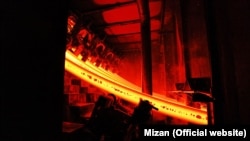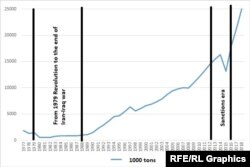A top Iranian official has claimed that Iran’s steel production increased 40 times since the 1979 Islamic Revolution.
Deputy for the Ministry of Industry, Mining and Trade Jafar Sarqini told IRNA Feb.5 that the country’s steel production capacity increased from 600,000 to 34 million tons.
Regardless of the miscalculation of the growth rate, which should be 55.66 fold if true (not 40 fold), Sarqini’s mentioned figure is in contrast with both official Iranian and the international statistics, though the huge growth in Iran’s steel production during last 40 years is a reality.
According to the World Steel Association, before Islamic Republic, Iran was producing about 1.8 million ton of raw steel, but the figure soared to 25 million tons in 2018, which indicates about 13-fold growth.
After the revolution, the production level declined to one third at 0.5 million tons per year in average in 1980s due to the Iran-Iraq war, but then started soaring thanks to huge investments, until international sanctions (2012-2016) hit on the nuclear issue. After the elimination of sanctions, it resumed growth with a more rapid pace.
Iran exported 10 million tons of raw steel and steel products last year.
Its raw steel production grew about 18% year-on-year to 25 million tons in 2018, according to World Steel Association.
Alongside raw steel, the country’s steel products (girder, rebar, rolled sheet, etc) also experienced a good performance during current Iranian fiscal year starting March 21, 2018.
| 9-month (million tons) | Year-on-year change | |
| Production | 15.928 | 9% |
| Imports | 730 | -56% |
| Exports | 2.148 | 100% |
Source: Steel Producers Association
It is not clear whether the country’s steel production can keep its growth rate in the coming years as U.S. has re-imposed sanctions on Iran, but recently the Iran Steel Producers Association warned that the country’s exports is plunging due to sanctions.
The official statistics also doesn’t show any monthly decline in steel exports until the end of 2018, though the year-to-year growth pace decelerated from 138 percent in the first half of the year to 100% in the nine months.
Steel Producers Association has also put the 2018 raw production level at 25 million tons, despite Sarqini’s claim.
Major steel firms and perspectives
Iran’s iron ore reserves stand at 5 billion tons, but they are located mostly in the central areas, which suffer from water shortage and are considered arid. Huge amount of water is needed for steel industry. In the process of converting iron ore to one kilogram of steel, some 5-7 liters of water is consumed in Iran. According to official statistics, with the current 96 billion cubic meters (bcm) annual water consumption in the country, Iran would face 40 bcm per year water deficit in 2040-2050.
Nevertheless, the country has planned to increase annual steel production capacity to 55 million tons by 2025.
Iran’s steel industry started in 1950s but progressed in the second half of 1970s and then flourished after 1990s. Currently, Esfahan's Mobarakeh Steel Company with 350,000 workers produces more than one third of Iran’s total production. About 73 trillion rials (one billion dollars based on 2017 rates) have been invested in this company since 2014 and it has planned to increase annual production from current 9.5 million tons to 25 million tons by 2025.
Its gross revenues increased by 46% year-on-year to 160.15 trillion rials (or about $1.5 billion based on current exchange rates) during nine months of current fiscal year, according to the company’s official statistics, but mostly due to plunging value of the rial against the dollar that pushed its exports and domestic sale revenues up. The dollar has risen almost three fold from late 2017.
U.S. imposed sanctions on the Mobarakeh Company last October and its future prospects remain a big question today.
Esfahan and Khouzestan steel Companies are other major firms in this sector. These three companies produce 70 percent of the country’s total steel.







